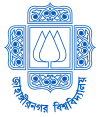
Ebadullah Khan Associate Professor, Department of Geography & Environment
PROFILE
SHORT BIOGRAPHY
Ebadullah Khan (born in 1986) is an Associate Professor at the Department of Geography and Environment, Jahangirnagar University, Dhaka, Bangladesh where he has been working as a faculty since December 2014. He has been conducting different undergraduate and graduate research and taught courses of physical geography, such as: Biogeography, Soil Geography, Disaster Risk Management, GIS and RS in Landscape Ecology, Environmental Monitoring, GIS and RS for Land use and Land Evaluation, Digital Image Processing, Fieldwork Techniques and Projects, Map and aerial photo interpretation. Besides, he has been supervising students’ dissertation report of B.Sc. (Hounours) and M.Sc. level in every academic year.
Mr. Khan graduated with 2 years Master of Science (MSc) in Natural Resources Management at ITC (Faculty of Geo-information Science and Earth Observation), University of Twente, the Netherlands in 2023. His MSc thesis mainly focused on how moderate resolution remote sensing satellite image can be used to evaluate forest species diversity based on spectral variation hypothesis approach. In addition, he also completed Bachelor of Science (BSc) with Honours (2nd position) and Master of Science (MSc) with thesis (2nd position) in Geography and Environment at Jahangirnagar University, Dhaka, Bangladesh in 2009 and 2011 respectively. His research mainly focused on environment; more precisely it is about landscape ecology, disaster management with the application of Geographical Information System (GIS) and Remote Sensing (RS). He conducted different research project as a principal investigator related to environmental issues which were funded by Ministry of Science and Technology (MoST), University Grants Commission (UGC), and Jahangirnagar University, Bangladesh.
As a part of academic activities, Mr. Khan has written significant articles on environmental issues, specially on landscape patterns and processes, geo-informatics based spatial and morphological analysis of coast and forest dynamics, agricultural cropping pattern and disaster management which have been published in different national and international journals, such as: Modern Environmental Science and Engineering, USA (Doi: 10.15341/mese(2333-2581)/06.03.2017/007) and Indonesian Journal of Geography (DOI: http://dx.doi.org/10.22146/ijg.26655, website: https://jurnal.ugm.ac.id/ijg). Apart from this, Mr. Khan is a life member of Bangladesh National Geographical Association (BNGA).
RESEARCH INTEREST
Natural Resources Management, Application of Geo-information Science
JOURNAL PAPER
Assessing the Impact of Temperature and Rainfall on Forest Cover and Vegetation Dynamics in Chakaria, Cox's Bazar, The Jahangirnagar Review: Part II: Social Science, 49, 1, pp.127-148, 2025.
This research investigates the relationship between climatic factors, forest cover, and vegetation dynamics in Chakaria, Cox's Bazar, Bangladesh, concentrating on the years 2015, 2020, and 2024. By employing GIS and remote sensing methodologies, such as Landsat 8 OLI satellite imagery, NDVI analysis, and supervised classification, the study examines seasonal fluctuations in forest cover and vegetation during pre-monsoon and post-monsoon periods. Temperature and rainfall data, collected from the Bangladesh Agricultural Research Council and the Center for Hydrometeorology and Remote Sensing (CHRS) Data Portal, offer valuable insights into seasonal climatic patterns. The findings reveal distinct seasonal patterns, with temperature exerting a more pronounced impact on vegetation degradation during the pre-monsoon season, whereas rainfall significantly supports vegetation recovery in the post-monsoon period. Regression analyses indicate a moderate to strong correlation between climatic variables and forest cover dynamics, with temperature and rainfall influencing forest health an NDVI values differently. The supervised classification of land-use and land cover changes achieved high accuracy, validated through Kappa tests, underscoring the reliability of the methodological approach. This study highlights the critical role of
climatic variables in shaping forest ecosystems and vegetation health, particularly in climate-vulnerable regions like Chakaria. The research underscores the need for sustainable forest management practices and evidence-based policies to mitigate climate-induced challenges and ensure ecological resilience. The integration of climate data with spatial analyses provides valuable insights into the impacts of climate variability, offering a robust framework for future studies aiming to predict and manage the effects of environmental change in deltaic regions.
This research emphasized on “Detecting Vegetation Disturbance in Kutupalong Rohingya Camp Area, Ukhia using LandTrendr Model”. It mainly emphasized on the identification of pixel-based magnitude and direction of changes in vegetation cover due to disturbances caused by the Rohingya inhabitants based on Normalized Difference Vegetation Index derived from Landsat satellite imageries from 1984 to 2024. Ukhia is an Upazila located under Cox's Bazar district, is home to a substantial natural environment and vegetation cover. However, the local ecosystem and ecology have experienced considerable changes due to intensified human activities, including the establishment of large Rohingya refugee camps, illegal logging, and the impacts of climate change. Randomly selected reference points from camp area indicated a substantial decline of NDVI value (magnitude) from 0.8 to 0.1 which indicates a significant forest loss for the year of 2017 and 2018 which was not recovered in the subsequent years anymore. Hence, there is an abrupt or structural changes occurred in vegetation cover due to identified vegetation disturbance. For most of the sites, RMSE value was lower than 0.05 which indicates a better performance of the fitted LandTrendr model. It has been observed that severe vegetation loss and moderate vegetation loss occupy 16350 hectares and 53456 hectares including 24.99 % and 72.39% respectively regarding the total percentage of vegetation disturbance area. This research can give a proper direction to the concerned authorities in terms of identifying the sites where vegetation disturbances are continuously occurring including their magnitude and direction of change.
The Jahangirnagar Review, Part II: Social Science, Vol. 37(pp 189-203), 2013; ISSN 1682-7422. Inventorying Landscape Elements and Patterns: A Case on Southern Part of the Maheshkhali Island, Coxs Bazar,
This study focused on “Inventorying Landscape Elements and Patterns of the Maheshkhali Island, Cox’s Bazar”. It mainly emphasizes on the present Landscape elements and state of Landscape pattern of the Maheshkhali Island. It is an offshore island of the Bay of Bengal. Due to its geo-physical location, strong wave actions and wind flow are prevailing in the western side. On the other hand, in the eastern side, wave actions and wind flow are comparatively less strong. So a complex landscape pattern has been developed in the island. The data are collected from primary sources. Questionnaire survey, field observation, informal interview, Group discussion etc. methods and techniques are employed for data collection. The topo-sequences of the landscape were identified. Then the resources available and their state of utilization along the topo-sequences have been documented. Next attempt has been taken to identify and document the stresses developed due to the Land transformation among and within the broader landform units. Finally the research highlighted on the possible ways to mitigate the stresses on the landscape.
Modern Environmental Science and Engineering, (ISSN 2333-2581), June 2017, Volume 3, No. 6, pp. 419-423 Doi: 10.15341/mese(2333-2581)/06.03.2017/007 Academic Star Publishing Company, 2017 www.academicstar.us Two and Half Centurys Changes of World Largest Mangrove Forest: A Geo-informatics Based Study on Sundarbans Mangrove Forest, Bangladesh, India,The world largest mangrove forest Sunderbans is located the southern coastal zone of Bangladesh and India. The ecologically rich world heritage site (UNESCO-1997) Sundarbans have been playing important role to protect the natural disaster. The economic importance of mangrove ecosystem is remarkable for Bangladesh and India both country. The mangrove bio-diversity and ecosystem of Sundarbans have created world famous tourist spot. During the demographic growth the Sundarbans have been decreasing. This research focused on geo-spatial charge of this mangrove forest during last 244 years. Historical maps Geo-informatics tools and techniques specifically Remote Sensing (RS), Geographical Information System (GIS) have been used to explore these changes. About 56.48% of total Mangrove forest have been lost during last two and half century with 0.23% yearly trend. The last half century it have lost 0.62% per year. The decreasing rate of Indian part more than Bangladeshi part. That is dangerous massage for Natural disaster protect, economy, Mangrove ecosystem and bio-diversity.
Indonesian Journal of Geography Vol. 50, No. 1, June 2018 (41-48), ISSN 2354-9114 (online), ISSN 0024-9521(print), DOI: http://dx.doi.org/10.22146/ijg.26655, Coastline Dynamics and Raising Landform: A Geo-informatics Based Study on the Bay of Bengal, Bangladesh,The southern part of Bangladesh is bounded by the Bay of Bengal. Three major river systems such as; Brahmaputra-Jamuna, Ganges-Padma and Surma-Kusiara have been developed the Ganges-Brahmaputra-Meghna (GBM) floodplain, this are 80% area of Bangladesh. These rivers carry huge sediments from upper Himalayan region during at monsoon period. On the contrary, as the costal part of Bangladesh is open to the sea, so high wave actions, strong wind flow, tidal actions are prevailing here. Consequently, coastline of this part is unstable and dynamic. Coastline change dynamics is significant for disaster management, coastal planning and environmental management. For the delineation of coastline identification, Rennell’s map (1776), Landsat MSS (1976) and Landsat OLI (2016) images have been interpreted using the tools of Remote Sensing Technology and Geographic Information System (GIS) of Geo-informatics. During 240 years from 1776 to 2016 about 3892 km2 landform have been raised in coastal area of Bangladesh.
Academic Info
Period: 2021-2023
Master of Science (MSc) in Natural Resources Management
Period: 2009-2010
Master of Science (MSc) in Geography and Environment
Experience
Position: Associate Professor
Period: 20 September 2023 to Present
Serving as an Associate Professor at the Dept. of Geography an Environment, Jahangirnagar University, Savar, Dhaka-1342.
Position: Assistant Professor
Period: 2 February 2018 to 19 September 2023
Served as an Assistant Professor at the Dept. of Geography and Environment, Jahangirnagar University, Savar,Dhaka-1342
Position: Lecturer
Period: 15 December 2014 to 1 February 2018
Served as a lecturer at the Dept. of Geography and Environment, Jahangirnagar University, Savar,Dhaka-1342
Activity
Position: Participant_QGIS course
Period: 15 Sep to 25 Oct 2022
GIS and RS for Geospatial Solutions course with QGIS; a trained competence in: Geospatial data management and retrieval; Spatial analysis; Image reprojection, resampling and classification; Cartographic outputs from 15 September 2022 to 25 October 2022 (40 hours of instruction) at Faculty of Geo-Information Science and Earth Observation, University of Twente.
Position: Participant_workshop
Period: 13-14 April 2023
Digital Skills Programme on Introduction to Geospatial Raster and Vector Data with Python Workshop on 13 April 2023, organized by Faculty ITC (Geo-information Science and Earth Observation), University of Twente which was trained by Netherland E science center.
Position: Participants_Training course
Period: 08-12 December 2017
Training course on Spatial Analysis Using ‘R’ held during the 08-12 December 2017, organized by Institute of Remote Sensing, Jahangirnagar University(IRS-JU), Savar, Dhaka, Bangladesh.
Position: Participants_Training workshop
Period: 20-24 August, 2017
Training workshop on ‘Google Earth Engine’ held during the 20-24 August 2017, jointly organized by the Institute of Remote Sensing, Jahangirnagar University(IRS-JU), Savar, Dhaka, Bangladesh and International Centre for Integrated Mountain Development (ICIMOD) within the framework of SERVIR-HKH supported by the United States Agency for International Development (USAID) and National Aeronautics and Space Administration (NASA).
Contact
Ebadullah Khan
Associate Professor
Department of Geography & Environment
Jahangirnagar University, Savar, Dhaka-1342, Bangladesh.
Work Phone: +8802-7791421, Ext. 1224/125
Email: ekhan@juniv.edu

